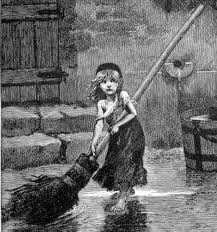Visited December 2011. Denver Colorado

This is my most recent grave venture, but I just had to move it to the front of the line.
The legend of Buffalo Bill was created by the man himself. But the facts of his life are legendary enough.
The legend of Buffalo Bill was created by the man himself. But the facts of his life are legendary enough.
 |
| Young Bill Cody |
 |
| Buffalo Bill and Sitting Bull |
Cody acquired the name ‘Buffalo Bill’ for the thousands of buffalo he hunted and killed over the years. But his fame came through his shrewd capitalization on western folklore through the creation of his ‘Buffalo Bill Wild West’ show. This extravaganza of all things western – horses, guns, Indians, outlaws - proved phenomenally successful over decades of performances. Among the major attractions to the show were sharpshooter Annie Oakley and Chief Sitting Bull. In 1887 the show began a triumphant tour of Europe, playing in several major cities. The show overwhelmed the Paris Exhibition of 1889 (playing in the shadow of the brand new Eiffel Tower). While in Europe Buffalo Bill had audiences with Queen Victoria and Pope Leo. The show also drew millions of visitors when it played New York in 1886-87. Many historians hold that, at the turn of the 20th Century, Buffalo Bill was the most recognizable celebrity in the world.

 |
| This picture speaks for itself |
Later in life Buffalo Bill retired from the show and turned his attention to taming the west through land development and irrigation. He became a successful rancher and businessman, founding the town of Cody, Wyoming. While visiting his sister in Denver, Cody passed away from kidney failure at the age of 71 in January 1917. According to his wife Louisa’s wishes (they had married in 1865) Cody was buried at the top of Lookout Mountain, in the Front Range of the Rockies just west of Denver. It is a tribute to Bill Cody’s life and legend that his death generally marks the end of what is understood as ‘the Old West’. In reporting his death one newspaper editor declared, "He has been more than picturesque; he has been worthwhile.”
 |
| Burial of Buffalo Bill in 1917 |
 |
| My kids in front of amazingly lifelike Buffalo Bill and Annie Oakley at the Bison Ranch Buffalo Museum in Arizona - Spring of 2004. |
My excursion to Buffalo Bill’s grave was entirely unexpected. In early December 2011 I had the opportunity to preach at Sovereign Grace Church in the Aurora area just southeast of Denver. I spent the evening talking with the Senior Pastor, Mark Alderton, and we got on the topic of things we like to do. I told him about this odd hobby and the blog that follows with it, and he mentioned that Buffalo Bill is the one famous person he knows is buried in the Denver area. I had to catch a plane back to Philly around 4:00 on Sunday. At around 1:30 after the service Mark grabbed me and said ‘I think we can make Buffalo Bill. We jumped in his car and we hightailed it 40 miles up into the front range – careening up the winding road to the top of Lookout Mountain. From the parking lot we dashed up to the top of the mountain to the grave site overlooking a beautiful view of Denver on the plain below. Back in the car we careened down the mountain and drove the fifty miles to the airport. I got through security and made my gate just in time to board the last flight out of Denver to Philadelphia. I think that’s just how Buffalo Bill would have done it himself.
 |
| Your Blogger and the intrepid Pastor Mark Alderton at Buffalo Bill's final resting place. His Medal of Honor marker is visible through the fence. |









































